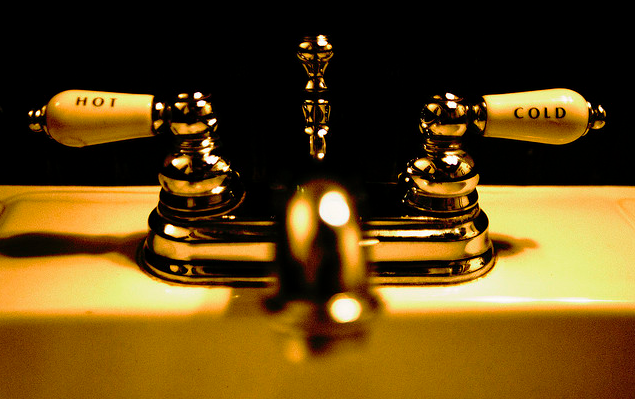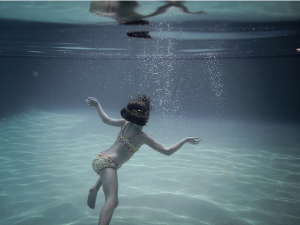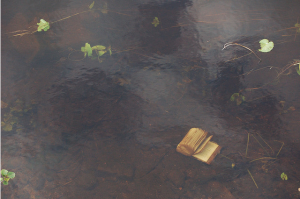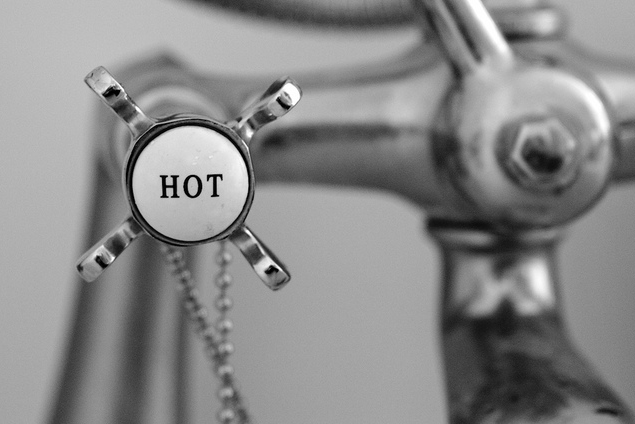
Running Hot & Cold
LIQUID LEARNING – The fluidity of progressive education and how to pick your own path. [fblike]
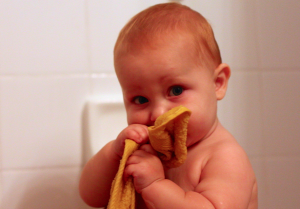
Photo courtesy Dewin Anguas Barnette
I was running a bath for my toddler, who is pretty neutral to bath time. Sometimes it’s a blast. Sometimes it’s a roadblock on the path to other fun. The one thing that changes or amplifies his mood is the moment he puts his foot in the water. It’s not bubbles or toys or the height of the water… it’s the temperature. The feel of it is either luring or shocking, it can be altered (and is) during the course of his bath, but it’s hard to shake that first step in, that first impression.
That’s when my worlds collided: What if bath temperature was a learning environment? What if the balance of training (cold water) and education (hot water) could make learning an enjoyable or dreaded experience? Are all the add-ons to lure a student into learning: reward, punishment, and job requirements are merely bubbles and toys? They can keep you in the tub for a while, but how much are you enjoying it? Would you want to go back in of your own free will? Would you want to share the concept of bath time with others because you loved it or because “Hey, if I had to suffer through it, you do too”?
Turn on the faucets. Drop in the bath salts. Let’s get a little deeper in the analogy, with this given:
HOT WATER = EDUCATION
“drawing out the person’s latent capacities for understanding and living”1
COLD WATER = TRAINING
“passing on specific information necessary to perform a specialized activity”2
THE BALANCE
Few people can or want to jump in to a bath that only has had the hot running (or just the cold). The extreme temperature is a shock to the system. Such a shock can do short and long term damage to not only the skin but also the mind and body.
When I draw a bath it’s a chemistry experiment, a little cold, a little hot, oh too much cold, more hot, less cold… this tweaking can go on for awhile if I have a leisurely chunk of time. If I’m rushed for a quick shower, I might throw both faucets half way, stick my hand in the stream, make sure it’s bearable, jump in and then tweak it. Either way, it’s a never-ending seesaw of hot and cold to find what I feel is needed in that moment.
And the moment’s always a little different depending on season, time of day, location, circumstances, and mood. I might want a brisk cold shower if I’m exhausted and have five minutes to get out the door. Or a long, warm bath when there’s no one in the house and I’ve got all the time in the world. Or I could grit my teeth and bare it during an outdoor shower with awful water pressure and what feels like sub-zero temperatures for the longest thirty-seconds of my life because well… I had to shower and couldn’t put it off any longer.
But I can’t imagine any of those examples as being my sole water temperature for, let’s say, the next thirteen years or seventeen with college or twenty-one with graduate school or… you get my point. How can we think that a set temperature, or even one that has a slight range of movement plus or minus a few degrees, can work for someone over a long period of time? And that’s just one person’s daily alterations of preference and situation. What happens when this one temperature is used for millions of students every year?
Training has its place. We need to have skills past down to us in order to create and think more efficiently. But it needs to be actively balanced with education. We need to know, feel or question what we’d like to explore in order to ask for the training we need to explore it and education helps us with that personal journey.
Institutions that are based heavily on one side, whether that’s education or training, are out of balance. Heavy training can lead to churning out great workers who need to have others tell them what to do before they do it. They have not explored their creative process or needs to become self-starters. Heavy education can do the exact opposite creating people who have many questions, searching for meaning but have no tools in order to create something substantial and challenging.
In both cases the student will be able to learn but at what cost? I can take a freezing shower if I absolutely have to, but I promise it won’t be for very long, I’ll most likely be kicking and screaming about it, cursing the person that made the shower, and dreading the thought of having to do it again anytime soon.
ACCLIMATE
The body needs to acclimate itself to its environment. I’ve heard it’s better to take a warmer shower in the summer because it makes it easier to stand the heat when you get out. Maybe Polar Bear Club members feels the same way about their ice-cold water dips in winter.
Regardless of what extreme you’d like your bath to be, cold or hot, it’s a gentler path to take it by degrees. To slowly add more hot water every couple of minutes, until you’re nice and relaxed. But if someone got into the last temperature of hot water you poured, they’d probably jump out in scalding pain. But to you, it’s perfect. Why? You’ve had quite some time of small notches in temperature to acclimate yourself. To get it perfect for you.
If I did this to my toddler, it would force him to not only withstand that which he doesn’t want (or need) to withstand but also it would show that I, the adult, know better. It might be a struggle at first, but after a while I, the parent authority, would win and my child would stay in the bath and force himself to acclimate, painfully, to my preference. In this example, it sounds cruel. It’s hard even to imagine it even as I type. And yet, how is this so different from forcing children to accept an adult authority’s preference/opinion on what they learn, how they learn, when they learn and from whom they learn?
The education system, among other long-standing institutions, is set up with this same underlying attitude. And what it truly teaches is to not trust one’s own senses and preferences.
There might be a goal temperature or length of bath time wanted for the child. But can’t the child be the one to slowly turn up the hot or cold in order to acclimate himself to his learning environment? Anyone with her hand on the faucet, who’s not in the bath, is only guessing. And to not actively question and listen to the one in the bath is crazy, egotistical and dangerous.
IMMERSION
Water is amazing. It makes us feel weightless and expands our possibilities. It even magnifies what you put in the water. Go test it, if you’ve forgotten. Put your hand under the water and see how it gradually appears larger.Learning can do that too. It can open up your possibilities, help you distribute the weight of your world in a more manageable way and magnify parts of your life so you can articulate them clearer.
When you lay in a bathtub, while the water is running, you can slowly feel yourself becoming lighter as the water gets deeper. The reverse feeling happens if you stay in the tub while it fully drains out. I’ve never felt heavier in my life than when I’ve done that. It’s a substantial feeling – taking your weight back after giving a lot of it over to the water. There is a new ownership of self.
There is something to be said about giving over some of your weight, life and burden to the water. It is often used in sports therapy because it helps take the pressure off the body in order to heal. The water, like a balanced learning atmosphere, supports you as you try something new. It evenly distributes the weight while you build yourself anew.
The temperature is more effective when you immerse yourself fully. Nothing like a cold breeze to run a perfectly good bath, just because you’re only in a few inches! In fact, any breeze feels like a cold one when you’re only in a few inches of water or dripping wet from a recent dunk. Plus, the healing nature of the water and temperature will reach more of your body at the same time when you’re fully immersed.
But just like the previous hypothetical baths, the water level changes depending on when, where and who is taking it. A bad water experience might make someone tense up and panic once the water gets to a certain level. Sometimes we just don’t have enough time to justify all the water it takes to fill a full tub, when a quick shower will suffice. Some people are uncomfortable or even fearful about the idea of a shower at all. They need to see where the water’s coming from, or they don’t feel fully immersed in the stream.
All of these scenarios can be transferred to hypothetical learning situations. How does a student like to learn in this moment – direct training? Indirect education? Multiple resources? Single mentor? Did they lose themselves in a full immersion setting, like a boarding school or conservatory, and so they are now fearful about getting in too deep?
My personal experience with learning is not exactly like yours. My level of immersion and intensity is not your level. And these levels are changing all the time.
TIMING
No matter how wonderful the water feels, in time it grows uncomfortable. It grows cold. You start to prune. You’ve got things to do outside the tub. You can’t stay in there forever, and honestly, who would really want to, outside of a few Douglas Adams characters?
Life has to be lived. You’ve got to go out there and get your hands dirty. Use the muscles you’ve been strengthening and healing in the water. Try out the ideas you’ve daydreamed about in the bath. Get perspective by feeling the temperature of the world outside.
Learning has the potential to be a daily ritual. If the water is inviting, healing and enjoyable, who wouldn’t want to keep coming back? And each time one comes back, the temperature and balance will be different – more education, less training this time… Lots of training, a dab of education this time…
But I will never fully enjoy a bath if I’ve been trained at a young age to ignore my personal preferences and senses. And if I don’t enjoy taking baths because of that, then I’ll avoid it as much as possible. And the best way to avoid baths is to not exert energy or get dirty… or try, anything.
Which leads us to a society of people who have learned how to dull the senses with (drugs, food, alcohol, mindless entertainment, debt), look to others to tell them what to do and how to live, and keep their head down and under the radar for fear of failure or exertion.
My point is this: I can’t draw the perfect bath for anyone but me. If I am drawing a bath for someone else, like a child, then I must hone my ability to read their signs and check in with them often about: how the water feels to them, what they’d like in the water to enjoy it more, how high the water line can be for them to feel safe and, eventually, teach them how to turn the hot and cold levers themselves.
1 Nachmanovitch, Stephen. Free Play. Penguin Putnam: New York, 1990.
2 Ibid
